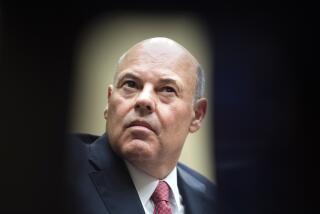Treasury says big banks can get more bailout funds
The federal government released details of its “stress test” for major banks Wednesday, saying they must be strong enough to weather a worse-than-expected economic scenario including a 22% drop in home prices this year and unemployment topping 10% next year.
As part of its revamped plan to restore confidence in the financial system and eventually restart lending, the Obama administration said big banks judged too weak to cope with losses on toxic securities and other assets would get six months to raise fresh capital from private investors.
If they couldn’t raise that capital, the Treasury Department would force them to take more government money. Either way, the banks would remain strong enough that customers and investors wouldn’t have to worry about their survival, senior administration officials said.
An index of bank stocks, which slumped after Treasury Secretary Timothy F. Geithner outlined the stress-test and capital-infusion plans two weeks ago, rallied on the release of the details and the possibility that the test might be less burdensome than banks and Wall Street had feared.
The BKX index of 24 bank stocks rose 2.4% after surging 13% on Monday. That helped broader indexes hold on to much of their gains of the day before. The Standard & Poor’s 500 index slipped 1.1% after jumping 4% on Monday.
The stock market also was encouraged for a second day by Federal Reserve Chairman Ben S. Bernanke, who reiterated before a congressional panel that officials didn’t plan a full-scale nationalization of banks that would wipe out shareholders’ stakes even if the government wound up with “substantial” holdings in ailing Citigroup Inc. and other banks.
Banks received $250 billion in the first round of the $700-billion financial rescue program. Officials on Wednesday said it was too early to speculate how much additional taxpayer funding might be needed for the latest phase. Regulators will work with the banks’ own risk experts to assess how the institutions would fare under a “baseline” scenario, an average of projections by mainstream economists, as well as worse-than-expected conditions.
The baseline scenario calls for gross domestic product -- a measure of the economy’s total output -- to fall 2% this year, while the adverse scenario envisions a 3.3% downturn. For all of 2008, GDP grew 1.3%. That included a 3.8% annualized rate of decline in the last three months of the year, representing the economy’s most severe contraction since 1982.
The stress-test assessments are to be completed by April.
Banks regularly run their own “what if” projections, and Bank of America Corp. Chairman Ken Lewis told Bloomberg TV that the plan wouldn’t pose a problem because it employed assumptions similar to those the company had used.
Nancy A. Bush, a banking analyst at NAB research in Sand Hill, N.J., voiced a similar sentiment. “The stress test -- baseline and more severe case -- does not seem to be anything more onerous than what the banks had been doing internally,” she said.
Citigroup, JPMorgan Chase & Co. and Wells Fargo & Co. said it was too early to comment on the program.
The assessments, which began Wednesday, are part of what senior administration officials described as an attempt to look two years into the future -- beyond regulators’ usual outlook of a year or less -- with the aim of preparing the government to take actions to ensure the stability of the financial system.
In a joint statement, the Treasury, the Federal Reserve and three regulatory agencies said the nation’s largest financial firms -- defined as the 19 bank holding companies with more than $100 billion each in assets -- currently each have a net worth high enough for them to be considered well-capitalized.
The new capital assistance plan is designed to maintain that status at the 19 institutions, which collectively hold two-thirds of all U.S. bank assets. The goal is “to ensure that major U.S. banking organizations have sufficient capital to perform their critical role in our financial system on an ongoing basis and can support economic recovery, even in more severe economic downturns,” the statement said.
The government doesn’t plan to release stress-test results but said the public was likely to learn which banks passed as the institutions tried to raise funds or reported that they needed no new capital. Any taxpayer investments -- the banks can request bailout funds immediately if they desire -- would be disclosed.
The Treasury would invest by buying preferred shares issued by the bank that could be converted into common stock at a discount. The conversion price would equal 90% of the common stock’s average price over the 20 trading days that ended Feb. 9.
But bank stocks have fallen sharply since then. So with new infusions the government could find itself locking in conversion prices higher than the current market prices of a bank’s common stock.
Shares of Citigroup, the bank considered likeliest to need additional capital, traded at $3.85 on average in the 20 sessions that ended Feb. 9, so the government would get preferred stock convertible into common stock at $3.47 a share. But Citigroup’s stock closed Wednesday at $2.52. That indicates the government would be paying a premium of 38%, not getting a 10% discount.
The new preferred stock would pay a 9% annual dividend and convert into common stock at the bank’s option at any time, subject to regulatory approval. After seven years, if the company doesn’t redeem the shares, they convert automatically into common stock.
In the first half of the bailout, the government bought preferred stock that paid a dividend of 5% for five years and 9% after that. Under the plan described Wednesday, banks can exchange that stock at any time for the new 9% convertible preferred shares.
--
More to Read
Inside the business of entertainment
The Wide Shot brings you news, analysis and insights on everything from streaming wars to production — and what it all means for the future.
You may occasionally receive promotional content from the Los Angeles Times.











